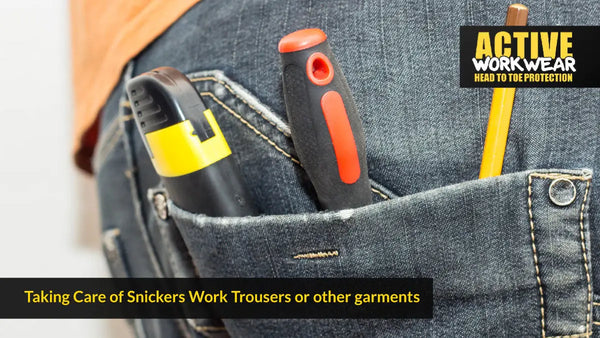Taking Care of Snickers Work Trousers or other garments
- by Mike Johnson
Taking Care of Snickers Work Trousers or other garments
You might be wondering if washing your Snickers Work Trousers often can impact the level of protection they provide. Yes, it can!
All workwear and PPE garments must be clean in order to be safe and meet the standard. Dirty garments will significantly decrease visibility and other properties and may put you in danger.
How to wash your Snickers Work Trousers
Frequent washing helps materials in your Work Trousers last much longer, as dirt and dust can ruin fibres by abrasion. Longer service life for Snickers Work Trousers means better value for money and less environmental impact. In addition, the flame and heat protection in protective clothing made of fabrics with inherent flame-resistant properties cannot be cleaned or worn out.
Frequent washing ensures that the garments do not contain any soil, dirt or grim or flammable particles that will compromise the protecting properties.
Keep your workwear and PPE clean to stay safe!
One of the best ways to keep your work garments looking their best is by following the washing instructions on the care label. Make sure to zip and button all garments and turn them inside out before washing. This helps to prevent damage to the fabric.
When washing clothes with reflective details, turning them inside out is important to preserve the reflection capabilities.
When washing clothes with reflective details, turning them inside out is important to preserve the reflection capabilities.
Many different types of detergent are available, so it is essential to choose the right one for the job.
Choose an organic detergent that is friendly to the environment and your skin to prevent skin irritation. Use a special wool detergent for woollen garments to protect them from damage.
Choose an organic detergent that is friendly to the environment and your skin to prevent skin irritation. Use a special wool detergent for woollen garments to protect them from damage.
Do not use more detergent than necessary, as this can harm the environment and your clothes. Instead, only use the amount specified on the label to avoid leaving lumps of detergent on your clothes.
Avoid using softener, as it may reduce the fabric's performance and contain many hazardous chemicals that are not always listed on the label. Softener and soap-based detergents should also be avoided when washing personal protective equipment (PPE) garments, as they can leave traces of either fat/grease from soap or chemicals which could counteract the properties of the fabrics.
The best way to save energy when washing and drying clothes is to use lower temperatures where possible, and to make sure that the clothes are hung up to dry immediately after being washed. This will help to avoid creases and keep the clothes looking their best. It is also best to dry clothes outside in the air or on a drying rack, as this uses less energy than a tumble dryer. However, some garments may need to be tumble dried at a high temperature in order to retain their properties – so always check the label carefully before doing so.
Wash your clothes inside out to protect reflective materials and prints. Wool due to it's natural qualities does not need to be washed as often as cotton or man-made materials. Follow the garment's care instructions carefully for rainwear, as it may feature taped seams or other waterproof qualities. Some rainwear must be tumbled dried or ironed to renew the water-resistance.
Carefully inspect your workwear if it has been exposed to fire or other chemicals that could burn and check if damaged before cleaning, as it may require wear before reuse..






